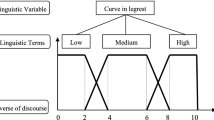Abstract
This research aims at developing a new fuzzy activity finish time estimation model for project scheduling management. With the application of the fuzzy quality function deployment (FQFD) and fuzzy analytic hierarchy process (FAHP) methods, the degree of fuzziness for every project activity is calculated in accordance with considerations of project uncertainties. These uncertainties are measured by the risk level of such project-related characteristics as time limit, activity start time, budget, manpower, technological difficulty, and facility requirements. In this paper, rather than applying the de-fuzzification technique to obtain the crisp activity duration for project scheduling, the fuzzy finish time estimation method for every activity is proposed based on the degree of fuzziness. The corresponding fuzzy activity duration time plot is also developed in a new fuzzy Gantt chart. The proposed model can provide a reasonable fuzzy finish time estimation for every activity, while most scheduling methods only provide the finish time of the entire project. Compared to existing models, this time estimation model and its corresponding Gantt chart are predicted to have higher reliability and practical application in project management and scheduling.
Similar content being viewed by others
References
Ash, R.C., Pittman, P.H., 2008. Towards holistic project scheduling using critical chain methodology enhanced with PERT buffering. International Journal of Project Organization and Management, 1(2):185–203. [doi:10.1504/IJPOM.2008.022191]
Azaron, A., Perkgoz, C., Sakawa, M., 2005. A genetic algorithm approach for the time-cost trade-off in PERT networks. Applied Mathematics and Computation, 168(2): 1317–1339. [doi:10.1016/j.amc.2004.10.021]
Azaron, A., Katagiri, H., Sakawa, M., Kato, K., Memariani, A., 2006. A multi-objective resource allocation problem in PERT networks. European Journal of Operational Research, 172(3):838–854. [doi:10.1016/j.ejor.2004.11.018]
Banerjee, A., Paul, A., 2008. On path correlation and PERT bias. European Journal of Operational Research, 189(3): 1208–1216. [doi:10.1016/j.ejor.2007.01.061]
Bottani, E., 2009. A fuzzy QFD approach to achieve agility. International Journal of Production Economics, 119(2): 380–391. [doi:10.1016/j.ijpe.2009.02.013]
Bottani, E., Rizzi, A., 2006. Strategic management of logistics service: a fuzzy quality function deployment approach. International Journal Production Economics, 103(2): 585–599. [doi:10.1016/j.ijpe.2005.11.006]
Chen, C.T., Huang, S.F., 2007. Applying fuzzy method for measuring criticality in project network. Information Sciences, 177(12):2448–2458. [doi:10.1016/j.ins.2007.01.035]
Chen, M.K., Hsu, S.P., 2004. Fuzzy critical chain based project management. Journal of the Chinese Institute of Industrial Engineers, 21(2):167–176. [doi:10.1080/10170660409509398]
Chen, S.P., 2007. Analysis of critical paths in a project network with fuzzy activity times. European Journal of Operational Research, 183(1):442–459. [doi:10.1016/j.ejor.2006.06.053]
Chen, Y., Fung, R.Y.K., Tang, J., 2006. Rating technical attributes in fuzzy QFD by integrating fuzzy weighted average method and fuzzy expected value operator. European Journal of Operational Research, 174(3):1553–1566. [doi:10.1016/j.ejor.2004.12.026]
Cheng, C.H., Mon, D.L., 1994. Evaluating weapon system by analytic hierarchy process based on fuzzy scales. Fuzzy Sets and Systems, 63(1):1–10. [doi:10.1016/0165-0114(94)90140-6]
Cohen, I., Mandelbaum, A., Shtub, A., 2004. Multi-project scheduling and control: a process-based comparative study of the critical chain methodology and some alternatives. Project Management Journal, 35(2):39–50.
Franceschini, F., Rupil, A., 1999. Rating scales and prioritization in QFD. International Journal of Quality & Reliability Management, 16(1):85–97. [doi:10.1108/02656719910250881]
Goren, S., Sabuncuoglu, I., 2008. Robustness and stability measures for scheduling: single-machine environment. IIE Transactions, 40(1):66–83. [doi:10.1080/07408170701283198]
Kahraman, C., Ertay, T., Büyüközkan, G., 2006. A fuzzy optimization model for QFD planning process using analytic network approach. European Journal of Operational Research, 171(2):390–411. [doi:10.1016/j.ejor.2004.09.016]
Kutanoglu, E., Wu, S., 2004. Improving scheduling robustness via preprocessing and dynamic adaptation. IIE Transactions, 36(11):1107–1124. [doi:10.1080/07408170490500681]
Leus, R., Herroelen, W., 2004. Stability and resource allocation in project planning. IIE Transactions, 36(7):667–682. [doi:10.1080/07408170490447348]
Liang, T.F., 2009. Fuzzy multi-objective project management decisions using two-phase fuzzy goal programming approach. Computer and Industrial Engineering, 57(4): 1407–1416. [doi:10.1016/j.cie.2009.07.010]
Lin, M.C., Wang, C.C., Chen, T.C., 2006. A strategy for managing customer-oriented product design. Concurrent Engineering, 14(3):231–244. [doi:10.1177/1063293X06068390]
Liu, S.T., 2003. Fuzzy activity times in critical path and project crashing problems. Cybernetics and Systems, 34(2): 161–172. [doi:10.1080/01969720302865]
Liu, Y.C., Chuang, C.Y., Yang, S.M., 2008. Application of Fuzzy QFD for Knowledge Acquisition in Product Design. Proceedings of the 9th Asia Pacific Industrial Engineer and Management Systems Conference, p.2048–2059.
Long, L.D., Ohsato, A., 2008. Fuzzy critical chain method for project scheduling under resource constraints and uncertainly. International Journal of Project Management, 26(6):688–698. [doi:10.1016/j.ijproman.2007.09.012]
Tukel, O.I., Rom, W.O., Eksioglu, S.D., 2006. An investigation of buffer sizing techniques in critical chain scheduling. European Journal of Operational Research, 172(2): 401–416. [doi:10.1016/j.ejor.2004.10.019]
Vanegas, L.V., Labib, A.W., 2001. A fuzzy quality function deployment (FQFD) model for deriving optimum targets. International Journal of Production Research, 39(1): 99–120. [doi:10.1080/00207540010005079]
Wang, J.H., Hao, J., 2007. Fuzzy linguistic PERT. IEEE Transactions on Fuzzy Systems, 15(2):133–144. [doi:10.1109/TFUZZ.2006.879975]
Yakhchali, S.H., Ghodsypour, S.H., 2010. Computing latest starting times of activities in interval-valued networks with minimal time lags. European Journal of Operational Research, 200(3):874–880. [doi:10.1016/j.ejor.2009.01.051]
Yeo, K.T., Ning, J.H., 2006. Managing uncertainty in major equipment procurement in engineering projects. European Journal of Operational Research, 171(1):123–134. [doi:10.1016/j.ejor.2004.06.036]
Zammori, F.A., Braglia, M., Frosolini, M., 2009. A fuzzy multi-criteria approach for critical path definition. International Journal of Project Management, 27(3):278–291. [doi:10.1016/j.ijproman.2008.03.006]
Author information
Authors and Affiliations
Corresponding author
Rights and permissions
About this article
Cite this article
Liu, Yc., Yang, Sm. & Lin, Yt. Fuzzy finish time modeling for project scheduling. J. Zhejiang Univ. Sci. A 11, 946–952 (2010). https://doi.org/10.1631/jzus.A1001115
Received:
Accepted:
Published:
Issue Date:
DOI: https://doi.org/10.1631/jzus.A1001115
Key words
- Fuzzy quality function deployment (FQFD)
- Fuzzy analytic hierarchy process (FAHP)
- Fuzzy Gantt chart
- Project management
- Project scheduling




